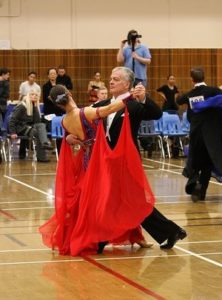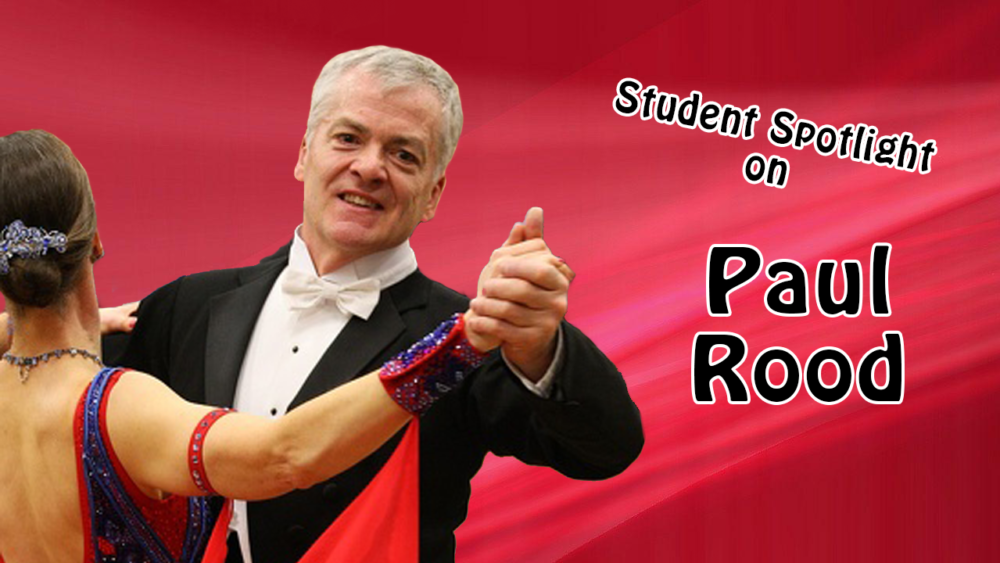Social dancing, competition dancing, lessons and formation teams. Everyone has their preferences when it comes to ballroom dancing, but few can say they’ve tried it all. One of those exceptions is Paul Rood, a student who has been with Aria Ballroom since the very beginning… and with Simeon and Kora even longer! So we wanted to catch up with Paul and ask about his diverse and extensive dance background. We were in for a surprise!
We asked him how he started dancing. He gave a little smile, just gracing the corner of his mouth, and said,
“When I was ten, I heard a song on the radio that called to me. I got up and started moving my feet in a circular pattern. Years later, after I had had some training in music, I realized that I had been trying to waltz. I thought; where did that come from?” He was born in rural Midwest so ballroom dancing wasn’t very popular, especially at that time. “I concluded that I had a rare waltz gene that expresses itself only in about one person in ten thousand,” he continued. “It was imprinted in my DNA.” Of course, at a time when rock n’ roll and disco was the craze, wanting to Waltz just wasn’t an accepted thing to do, especially in such an isolated setting. So, he “kept my condition a secret.”

Paul and Susan performing a Waltz
Eventually he made his way to Seattle, and we are so happy he did! Immediately upon arriving in Seattle, he went about meeting like-minded people and working his way into the local ballroom dance community. As he started to attend more events, he soon discovered that, at the time, there was a real deficit in women dancers his age. He tried to start a few dance partnerships with the few women that did appear, but for one reason or another, those partnerships always fell through.
Still, Paul kept dancing. He kept hoping that the right partner would come along. Little did he know that it would take him 15 years, but the right partner would come along, not only in dancing but in life as well!
After 15 years of searching for the right partner, Paul was getting desperate. He was an occasional church-goer, and one day a member of his church invited him to a prayer circle. He grabbed an envelope and wrote down his prayer, asking for a partner that met only nine criteria. Only nine! Some of his criteria included height: “between 5′-4″ and 5′-7″; but not a fraction more than 5’7″ “ and “must have time in her busy schedule to study dance.” Of course Paul included the most important criterium: “must have the same waltz gene as I do.”
“I submitted the prayer and waited for the phone to ring,” Paul reminisced. Soon he forgot about the prayer as he went about his daily life. But “after six weeks, the phone did ring. It was Susan, a young woman I had met at a party thrown by a mutual dance friend. She asked if I was going to Century Ballroom on Saturday. I said, ‘I guess I am.’ It took me about four months to remember, but one day, I had a measuring tape in my hand, and on a whim, I stretched it out behind Susan. She was 5′-7″ exactly and not a fraction more. Then my prayer came back to me and I realized that Susan was everything that I had asked for.”
All of that happened in the year 2000. Immediately he and Susan started dancing together and seeing each other off the dance floor. In addition to social dancing, they started taking lessons together and joined the studio’s adult formation team. In formation team dancing, there are a number of couples, between six and twelve couples, that perform choreography as a team to create different formations on the dance floor. Formation team dancing is an entirely different skill compared with social or competitive dancing. But for Paul, it was the camaraderie that he enjoyed most about his time on the studio’s formation team. “Team dancing provides a group of dancers (a chance to) become close friends and a social circle.” When asked what he liked best in his formation team experience, he replied, “I especially enjoyed the elegance of the Viennese Waltz formations.”
In addition to formation team dancing, Paul and Susan decided to dive into competition dancing. This ultimately became Susan’s favorite form of ballroom dancing. “Once she experienced the thrill of being in a semi-final and getting a call back,” Paul said, “she was hooked.”
We asked Paul what it was about competition dancing that he enjoyed. “Competition forces you to focus and gives a specific occasion to present your best effort,” he explained. But “in 2018, I told Susan I was too old to do competition justice. Go find a younger man. So she did.”
That wasn’t the end of Paul’s dancing, though. He began the hunt for another dance partner, this time just a casual partner that he could practice and take lessons with. One day he was at the Aria Ballroom dance during one of the mixers, he was paired with a woman he had never met or danced with before. He decided to try her out, and she stayed with him perfectly the whole way through! Paul knew he had found his new practice partner.

Paul and Susan dancing the Tango
“While I no longer compete,” he said, “I still take lessons and try to improve. To me, there is nothing better than when you, your partner, and the music are all aligned in harmony. Your partner becomes music in your arms, the music become physical movement, and you are flowing like a river with both. This is the holy trinity of ballroom. It’s even better if you can do that lead-follow. That is really a treat.”
Paul’s connection with Aria Ballroom goes back to the days before Aria Ballroom even existed, all the way back to 2010. Aria Ballroom principals Simeon and Kora was just wrapping up their amateur careers and preparing to turn professional. At their final amateur competition, Paul was watching in the audience.
“When I watched Simeon and Kora do their final amateur competition. I thought, Wow! That Simeon is really good! I have to book some lessons with him before his schedule fills up. So I did.”
Simeon worked with Paul and Susan for several lessons before, one day, “he had to cancel and offered a lesson with Kora. We accepted the substitution. When I danced with Kora, I realized why Simeon was such a good dancer.”
When Simeon and Kora opened Aria Ballroom in 2012, Paul and Susan were one of the first couples through the doors and have become fixtures at Aria’s Saturday night dances. “My favorite form is social dancing,” Paul admits. “It tests how well you are communicating to your partner through your lead, you have to constantly adjust to a new partner, and adjust to the traffic in the ballroom.”
We asked what Paul enjoys most about Aria Ballroom. “Kora and Simeon and the other instructors at Aria have been a joy to me!” he effused. “What a talented group and what a positive place to study your obsession. It is also a joy, and humbling, to watch young people come into the studio and within a year or two, zoom right past my ability.”
Well, Paul, we at Aria Ballroom can happily say that it is a joy to have you and Susan in the studio. If any of you reading this article happen to be at one of our Saturday night dances, stop by and say hello to Paul. There are few students in the studio with as much passion for ballroom dancing as Paul, and any dance conversation with him with leave you feeling refreshed and invigorated. Happy dancing, Paul!

Comments are closed.